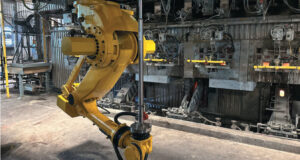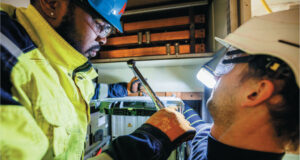Inland Empire Paper is among first to try a patented new seaming technology for quick and safe changes of dryer fabrics.
ROBERT PUHR
Inland Empire Paper Co. (IEP), located in Millwood, WA, near Spokane, has been in business since 1911. It manufactures more than 50 grades of newsprint and specialty papers using a combination of virgin mechanical and recycled fiber. IEP is the sole supplier of the famous peach-colored paper for the Financial Times in North America.
IEP’s #5 paper machine, installed in 2001, has a width of 225 inches (5.72 m) and operates between 3,800-5,000 fpm (1,160-1,524 m/min), depending on the grade being produced. The company prides itself on being innovative and responsive to customers. “We are always looking to improve our costs and operational efficiencies,” says Kevin Davis, production manager. “So, when a supplier-partner proposes an innovation that can improve our cost position or competitive advantage, we are very open to discussing and understanding the opportunity.”
A NEW WAY TO SEAM
That was the case when Jim Brink, West Coast business team leader for AstenJohnson (AJ), approached Davis and Luke Huntley, paper machine superintendent, about a new, patented seaming technology for dryer fabrics—QuickLink™—and suggested that IEP give it a try.
“Dryer sections are hot, humid, often dark, and just not a place where machine crews care to linger very long,” says Brink, who was a papermaker for many years before joining AJ. “QuickLink is a way to seam dryer fabrics that is faster, safer, and error-proof. It helps crews who have to make a fabric change in the dryer section get in and out as quickly and safely as possible. I thought that IEP could benefit from this.”

QuickLink enables machine crews to get in and out of the dryer section during a fabric change as quickly and safely as possible.
AstenJohnson’s seaming solution replaces traditional woven seams with an innovative polymer-bonded seam. The seam is independent of the weave of the fabric and can be efficiently produced.
“The initial bonding equipment and techniques for incorporating QuickLink were developed at our Belgium facility, where the first prototypes were also created,” says Blake Farmer, business leader for dryer products at AstenJohnson. “The prototypes were tested at our advanced products lab in Canada on our own proprietary seam testing and evaluation equipment. The prototypes were subjected to severe flex, wear, endurance, tensile, and hydrolysis conditions to simulate the most demanding dryer sections of any paper machine.”
Narrow fabrics were extensively tested on pilot machines. Then, field trials brought QuickLink out of the lab and into the real world—with full-size fabrics running on machines producing a variety of paper grades. “The testing has been extremely successful and we are in full production now,” Farmer says.
MILL TRIAL AT IEP
It didn’t take long for Huntley and Davis to weigh the risk-vs-reward of QuickLink and agree to a trial. Brink presented them with the experiences of other mills, and they felt that the risk was “neutral” with a potential upside. “We decided to try it on the 5th bottom dryer section,” Huntley says. “This is an easily accessible position than can be changed out if there are any problems.”
“We didn’t really anticipate a problem,” Davis says. “This mill’s relationship with AstenJohnson pre-dates the time I arrived here 25 years ago. There is a high level of trust with Jim and his team. They give us great service. They are good about making recommendations, even minor tweaks, to help us improve.”
Adds Huntley: “One of the things most appealing to us about trying QuickLink was its potential to reduce our downtime. The QuickLink seams mate together easily, making it virtually impossible to line up the loops incorrectly. This can be a huge time saver.”

QuickLink loops line up easily, almost like a zipper. The seam is below the plane of the fabric, which eliminates a potential wear point.
“Another aspect of QuickLink that is totally unrelated to machine performance is our ability to produce a finished fabric more quickly,” Brink says. “If IEP gets into an inventory crunch for any reason, and we have the base fabric in our facility, we bond the QuickLink seam without having to impact our weaving loom schedule and get them a replacement in a week or less.”
The QuickLink fabric for IEP’s 5th bottom position was 248 inches (6.3 m) wide and 127 feet (39 m) in length. “On a good day, IEP’s team can seam that fabric in about 10-12 minutes,” says Brink. “It took two of us just over three minutes to seam QuickLink.”
One of the benefits of the QuickLink seam that Huntley was anticipating is the fact that it has a very low profile—below the plane of the fabric. This eliminates a potential wear point. As of this writing, the fabric is running to expectations (200+ days and counting). Normal felt tension is between 12-14 pli and there is no seam distortion. “Everything looks fine,” Huntley says. “There is no sheet marking and the seam looks great. We recently ordered a QuickLink fabric for the 5th top dryer position.”
ERROR-PROOF
After discussions with customers about their seaming problems, the keywords that rose to the top were “fast” and “safe.” When AstenJohnson designers completed the creative process of developing a better seam, they added another keyword—“error-proof.”
“Traditional dryer fabrics are produced on a special weaving loom,” says Farmer. “An additional step is required to weave-back the yarns at the ends to create seaming loops. In addition to being time-consuming, this creates the potential for the ends of the yarns to stick up when they are cut off. These ends can pick the paper sheet. That is why clothing suppliers mark the fabric with ‘machine side’ and ‘sheet side’ so that only the smooth side of the fabric contacts the sheet.”
Brink adds, “With a traditional woven seam, the crews have to pay careful attention so that only the sheet-side of the fabric contacts the sheet. During the intensity of a machine shut, mistakes can happen and time can be lost if the fabric is seamed in the reverse direction. That can’t happen with QuickLink as there is no ‘wrong’ side—run direction is no longer an issue.”
Robert Puhr is president of Ad Hoc Communications, a firm specializing in corporate storytelling and case studies. He has been writing about the global pulp and paper industry since the late 1970s.
 Paper 360
Paper 360

